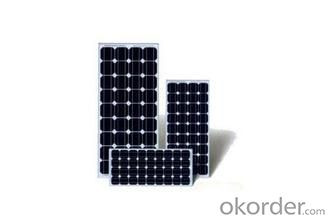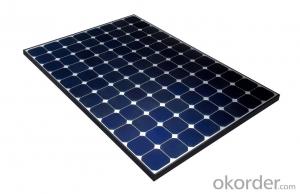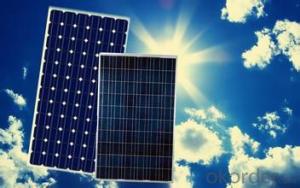150kw CNBM Monocrystalline Silicon Solar Energy Systems Cyprus Panel for Home Use
- Loading Port:
- Tianjin
- Payment Terms:
- TT OR LC
- Min Order Qty:
- 30 watt
- Supply Capability:
- 1000 watt/month
OKorder Service Pledge
OKorder Financial Service
You Might Also Like
Specification
150KW CNBM Monocrystalline Silicon Panel for Home Using
Production description
Off-the-grid homes are autonomous; they do not rely on municipal water supply, sewer, natural gas, electrical power grid, or similar utility services. A true off-grid house is able to operate completely independently of all traditional public utility services. The idea has been recently popularized by certain celebrities including Ed Begley, Jr.[1] who stars in Living with Ed[2] television show on the Home & Garden Television (HGTV) network. Actress Daryl Hannahpromotes off-grid living and constructed her home in Colorado according to This is several times larger than the total world energy consumption, which was 559.8 EJ in 2012.
Electrical power can be generated on-site with renewable energy sources such as solar (particularly with photovoltaics), wind, micro hydro, geothermal; with agenerator or Micro combined heat and power with adequate fuel reserves. Such a system is called a stand-alone power system. In addition, it is possible to simply eliminate electric power such as in Old Order Amish and Old Order
On-site water sources can include a well, stream, or lake. Depending on the water source, this may include pumps and/or filtration. Rainwater can also be harvested. Filters can be advanced running off an energy source of boiling and storage.Mennonite communities.
Feature
1.High conversion efficiencies resulting in superior power output performance.
2.Outstanding power output even in low light or high temperature conditions
3.Optimized design for ease of soldering and lamination
Physical characteristic
1. Rigorous quality control meets the highest international standards.
2. High-transmissivity low-iron tempered glass, strong aluminium frame.
3. Using UV-resistant silicon.
4. IS09001/14001/CE/TUV/UL
Packaging
26pcs in one carton 6pallets in 20foot container 14pallets in 40 foot container.
- Q: Are there any limitations to the lifespan of solar energy systems?
- Yes, there are limitations to the lifespan of solar energy systems. The most significant limitation is the degradation of the solar panels over time. Solar panels are made up of photovoltaic (PV) cells that convert sunlight into electricity. These cells degrade gradually, losing efficiency as they age. On average, solar panels experience a degradation rate of around 0.5-1% per year, which means that after 25-30 years, the panels might only produce around 75-80% of their original power output. Another limitation is the lifespan of other components in the solar energy system, such as inverters, batteries (if present), and wiring. Inverters, which convert the DC electricity generated by the solar panels into AC electricity for use in homes or businesses, typically have a lifespan of 10-15 years. Batteries, if used for energy storage, also have a limited lifespan, usually around 5-10 years. Wiring can deteriorate over time due to exposure to the elements, requiring maintenance or replacement. Furthermore, environmental factors can impact the lifespan of solar energy systems. Extreme weather conditions like hailstorms, hurricanes, or heavy snow can damage solar panels, reducing their efficiency or even rendering them inoperable. Additionally, excessive heat can accelerate the degradation of solar panels, shortening their lifespan. However, it is important to note that while solar energy systems have limitations, proper maintenance and regular inspections can help maximize their lifespan and performance. Many solar panels come with warranties that guarantee their performance for a certain number of years, often ranging from 20 to 25 years. Moreover, technological advancements and improvements in manufacturing processes are constantly being made, which may lead to longer-lasting and more efficient solar energy systems in the future.
- Q: How do solar energy systems affect the demand for traditional energy sources?
- Solar energy systems can significantly reduce the demand for traditional energy sources. As solar power becomes more accessible and affordable, more people and businesses are installing solar panels to generate their own electricity. This leads to a decrease in the reliance on fossil fuels, coal, or nuclear power, thereby reducing the demand for traditional energy sources. Ultimately, solar energy systems offer a sustainable alternative, minimizing the need for non-renewable energy and contributing to a greener and more energy-independent future.
- Q: Are there any risks of electrical arcing with solar energy systems?
- Yes, there are risks of electrical arcing with solar energy systems. Electrical arcing occurs when there is a breakdown in the insulation of electrical components, resulting in the flow of electricity through air or other non-conductive materials. This can lead to a fire hazard and damage to the solar energy system. Some potential causes of electrical arcing in solar energy systems include faulty wiring, loose connections, and damage to the solar panels. These issues can result in an increased risk of electrical arcing, which can cause overheating, melting of components, and even electrical fires. To mitigate the risks of electrical arcing, it is crucial to ensure that the solar energy system is installed and maintained by qualified professionals who follow industry standards and regulations. Regular inspections and maintenance should be conducted to identify and address any potential issues that could lead to electrical arcing. Furthermore, the use of high-quality electrical components and proper grounding techniques can help reduce the risk of electrical arcing. Implementing safety measures such as circuit breakers, surge protectors, and arc fault circuit interrupters (AFCIs) can also provide additional protection against electrical arcing. In summary, while solar energy systems offer numerous benefits, it is important to be aware of the potential risks of electrical arcing. By ensuring proper installation, maintenance, and adherence to safety guidelines, the risks can be minimized, allowing for the safe and efficient operation of solar energy systems.
- Q: Can solar energy systems be used to heat water?
- Yes, solar energy systems can be used to heat water. Solar water heating systems use the sun's energy to heat water for domestic or commercial use. These systems typically involve solar collectors that absorb sunlight and transfer the heat to water, providing an efficient and sustainable way to heat water.
- Q: Can solar energy systems be used in areas with frequent lightning strikes?
- Yes, solar energy systems can be used in areas with frequent lightning strikes. While lightning strikes can pose a risk to any electrical system, including solar panels, there are measures in place to mitigate this risk. Solar panels are designed to withstand various weather conditions, including lightning strikes. They are built to be durable and capable of handling external stressors, such as electrical surges caused by lightning. Additionally, solar panels are grounded using lightning protection systems to divert the electrical charge safely into the ground, reducing the risk of damage to the system. Furthermore, solar energy systems typically include surge protection devices and lightning arresters that help dissipate and redirect electrical surges caused by lightning strikes. These protective measures help safeguard the system and prevent any potential damage. It is important to note that while solar energy systems can generally withstand lightning strikes, it is still recommended to consult with a professional installer and follow local electrical codes and regulations to ensure proper installation and protection against lightning strikes.
- Q: What is the impact of snow or hail on solar panels?
- The performance and efficiency of solar panels can be significantly affected by snow or hail. When snow accumulates on the panels, it obstructs sunlight, causing a decrease in energy production. This reduced sunlight exposure leads to a decline in the overall power output of the solar installation. Likewise, hail can cause physical harm to the panels if the ice pellets are large or impact with high velocity. This harm can result in cracks, shattered glass, or internal structural issues. Once the panels are damaged, their ability to convert sunlight into electricity is compromised, leading to decreased efficiency. To minimize the impact of snow or hail, various measures can be taken. In snowy areas, panels can be installed at an angle to facilitate the sliding off of snow, reducing accumulation. Additionally, heating elements can be incorporated into the panels to melt snow and ice. However, these heating systems require additional energy, which may offset some of the benefits of solar power during snowy periods. Regarding hail, the use of tempered or impact-resistant glass for solar panels can help minimize damage. Furthermore, mounting systems that provide flexibility and shock absorption can absorb impact and reduce the risk of physical harm to the panels. In conclusion, although snow and hail can negatively affect solar panels, proper installation, maintenance, and protective measures can mitigate these impacts and ensure efficient generation of clean and renewable energy.
- Q: How do solar energy systems impact the energy poverty gap?
- Solar energy systems have the potential to significantly impact the energy poverty gap by providing clean and affordable electricity to those who do not have access to reliable energy sources. Energy poverty refers to the lack of access to electricity and modern energy services, which affects millions of people worldwide. One of the key advantages of solar energy systems is their ability to generate electricity in a decentralized manner, making them suitable for off-grid and rural areas where connecting to the traditional power grid is often challenging and costly. These systems can be easily installed and are scalable, allowing for customized solutions based on the energy needs of a particular community or household. By harnessing the power of sunlight, solar energy systems can provide a sustainable and reliable source of electricity, reducing the dependence on traditional fossil fuels that are often expensive and environmentally harmful. This, in turn, helps to alleviate the financial burden on individuals and communities, as solar energy can be generated for free once the system is installed. Furthermore, solar energy systems also have the potential to stimulate economic development in energy-poor regions. By providing access to electricity, solar systems enable the establishment of small businesses, such as charging stations for mobile phones, refrigeration units for storing perishable goods, or even micro-grids to power communal services like schools and healthcare facilities. These economic activities can create job opportunities and improve the overall quality of life in these areas. In addition to economic benefits, solar energy systems also contribute to environmental sustainability. By generating electricity from renewable sources, they help reduce greenhouse gas emissions and mitigate climate change. This is particularly important in energy-poor communities that often rely on traditional energy sources, such as kerosene lamps or diesel generators, which emit harmful pollutants and contribute to air pollution. In conclusion, solar energy systems have a profound impact on the energy poverty gap by providing clean, affordable, and sustainable electricity to those who lack access to modern energy services. They offer a decentralized and scalable solution that can stimulate economic development, improve quality of life, and contribute to environmental sustainability.
- Q: Can solar energy systems be used for powering telecommunications networks?
- Yes, solar energy systems can indeed be used for powering telecommunications networks. Solar power is a sustainable and renewable energy source that can be harnessed to generate electricity for various applications, including powering telecommunication infrastructure. Solar energy systems consist of solar panels that convert sunlight into electricity through the photovoltaic (PV) effect. These PV panels are typically installed on rooftops, ground-mounted arrays, or even integrated into the structure of telecommunication towers. They absorb sunlight during the day and convert it into direct current (DC) electricity. To utilize this electricity for powering telecommunications networks, an inverter is used to convert the DC electricity into alternating current (AC), which is the standard form of electricity used in most electronic devices. The AC electricity generated by solar panels can then be used to power telecommunication equipment such as base stations, antennas, transmitters, and receivers. The benefits of using solar energy systems for powering telecommunications networks are numerous. Firstly, solar energy is abundant and available in almost all geographical locations, making it a viable option for powering remote or off-grid telecommunication sites. This reduces the reliance on traditional grid electricity, which may not be available or reliable in certain areas. Secondly, solar power is environmentally friendly, emitting zero greenhouse gases during operation. By using solar energy, telecommunication networks can significantly reduce their carbon footprint and contribute to the global transition towards clean energy sources. Moreover, solar energy systems are low maintenance and have a long lifespan, providing a reliable and cost-effective solution for powering telecommunication infrastructure. Once installed, solar panels require minimal maintenance and can last for 25-30 years or even longer with proper care. In conclusion, solar energy systems can be effectively used for powering telecommunications networks. They offer a sustainable and reliable source of electricity, reduce environmental impact, and provide a cost-effective solution for remote or off-grid telecommunication sites. With the increasing focus on renewable energy, solar power is becoming an increasingly popular choice for powering various sectors, including telecommunications.
- Q: Can solar energy systems be used in disaster-stricken areas for emergency power supply?
- Yes, solar energy systems can be used in disaster-stricken areas for emergency power supply. Solar panels can generate electricity from sunlight, making them a reliable and renewable energy source even when traditional power grids are damaged or inaccessible. Solar energy systems can provide essential power for lighting, charging devices, running medical equipment, and other emergency needs, helping to alleviate the impact of disasters and support relief efforts.
- Q: Do solar energy systems require specialized cleaning?
- Yes, solar energy systems do require specialized cleaning. While solar panels are designed to be self-cleaning to some extent, they can still accumulate dirt, dust, pollen, bird droppings, and other debris over time, which can reduce their efficiency. Regular cleaning is necessary to ensure optimal performance. However, cleaning solar panels can be a delicate task, as they are made of sensitive materials. Using the wrong cleaning products or techniques can damage the panels and void their warranty. Therefore, it is recommended to hire professionals or follow the manufacturer's guidelines for cleaning solar energy systems.
Send your message to us
150kw CNBM Monocrystalline Silicon Solar Energy Systems Cyprus Panel for Home Use
- Loading Port:
- Tianjin
- Payment Terms:
- TT OR LC
- Min Order Qty:
- 30 watt
- Supply Capability:
- 1000 watt/month
OKorder Service Pledge
OKorder Financial Service
Similar products
Hot products
Hot Searches
Related keywords


























